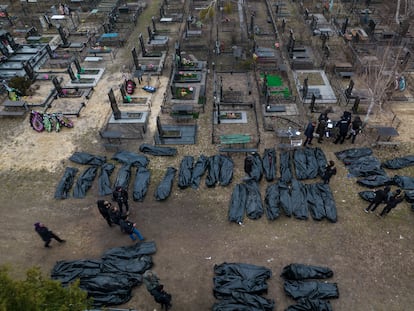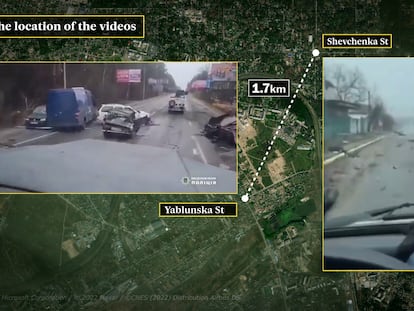The Ukraine war as of April 13: Russia prepares to intensify Donbas offensive
Moscow continued its attacks in the areas of Severodonetsk, Izyum, Mariupol and Kherson while it worked on ironing out logistical issues and reconstituting the forces it withdrew from Kyiv
April 13 | The new fronts of the war
The war in Ukraine has entered a new phase. The Russian army is working on its logistics and reconstituting the forces it withdrew from the battle of Kyiv, and which have not yet been reintroduced into Ukraine to fight, according to the Institute for the Study of War (ISW). While Russia prepares its assault on the eastern Donbas area, there are four ongoing goals: occupying Severodonetsk and Rubizhne in the Luhansk area, advancing from Izyum in the north towards Donetsk; controlling Mariupol and defending their positions in Kherson, in the south.
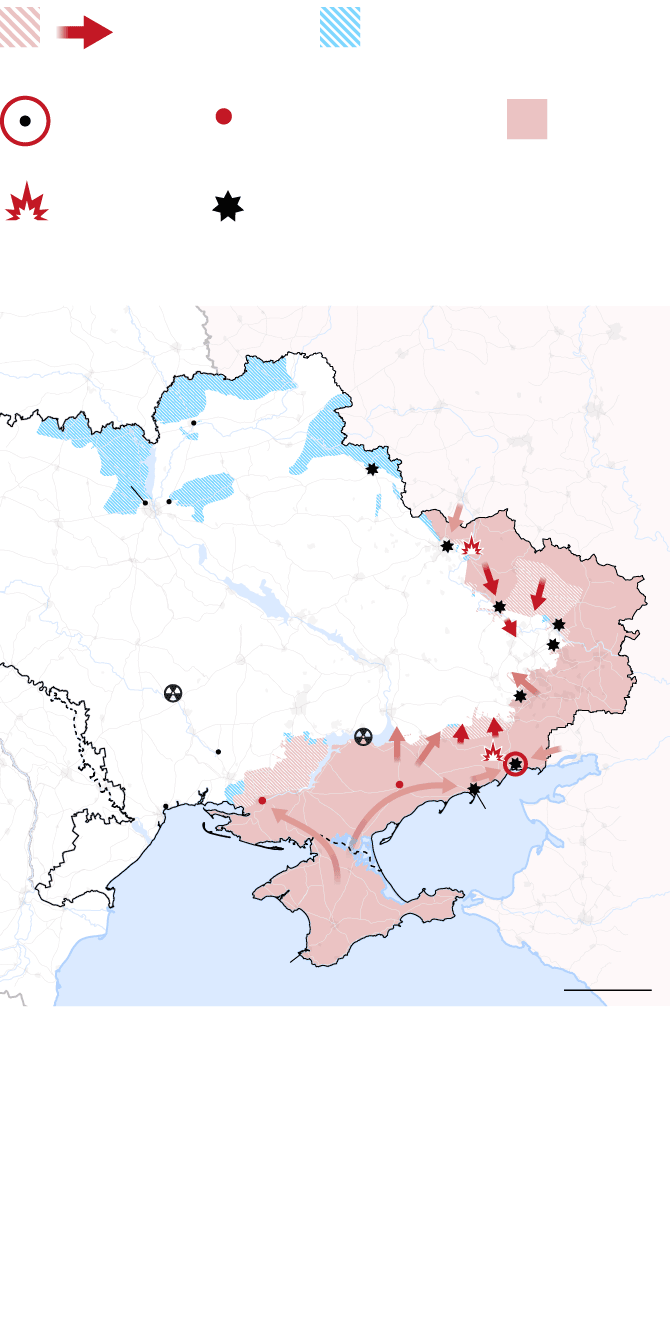
Russian
movements
Area recovered
by Ukraine
Besieged
city
City controlled
by the Russians
Russian
control
Recent
fighting
Recent
bombing
BELAURUS
Kursk
RUSSIA
Chernihiv
Sumy
Irpin
Brovary
Belgorod
Makariv
Kyiv
Kharkiv
Severo-
donetsk
Izyum
UKRAINE
Sloviansk
Popasna
DONBAS
Zaporizhzhia
Donetsk
Mykolaiv
MOLD.
Odessa
Melitopol
Mariupol
Kherson
Berdiansk
Sea of Azov
CRIMEA
Annexed by Russia
in 2014
Black Sea
250 km
Note: What does “control” mean? It requires exerting a physical influence over an area to prevent its use by the enemy. It could be achieved by occupying the area or by holding power over it with weapons. It does not imply any form of governance or legitimacy. Sources: Institute for the Study of War and American Enterprise Institute’s Critical Threats Project (for advances and areas under control); UK intelligence (besieged cities); EL PAÍS and other sources (fighting and airstrikes).
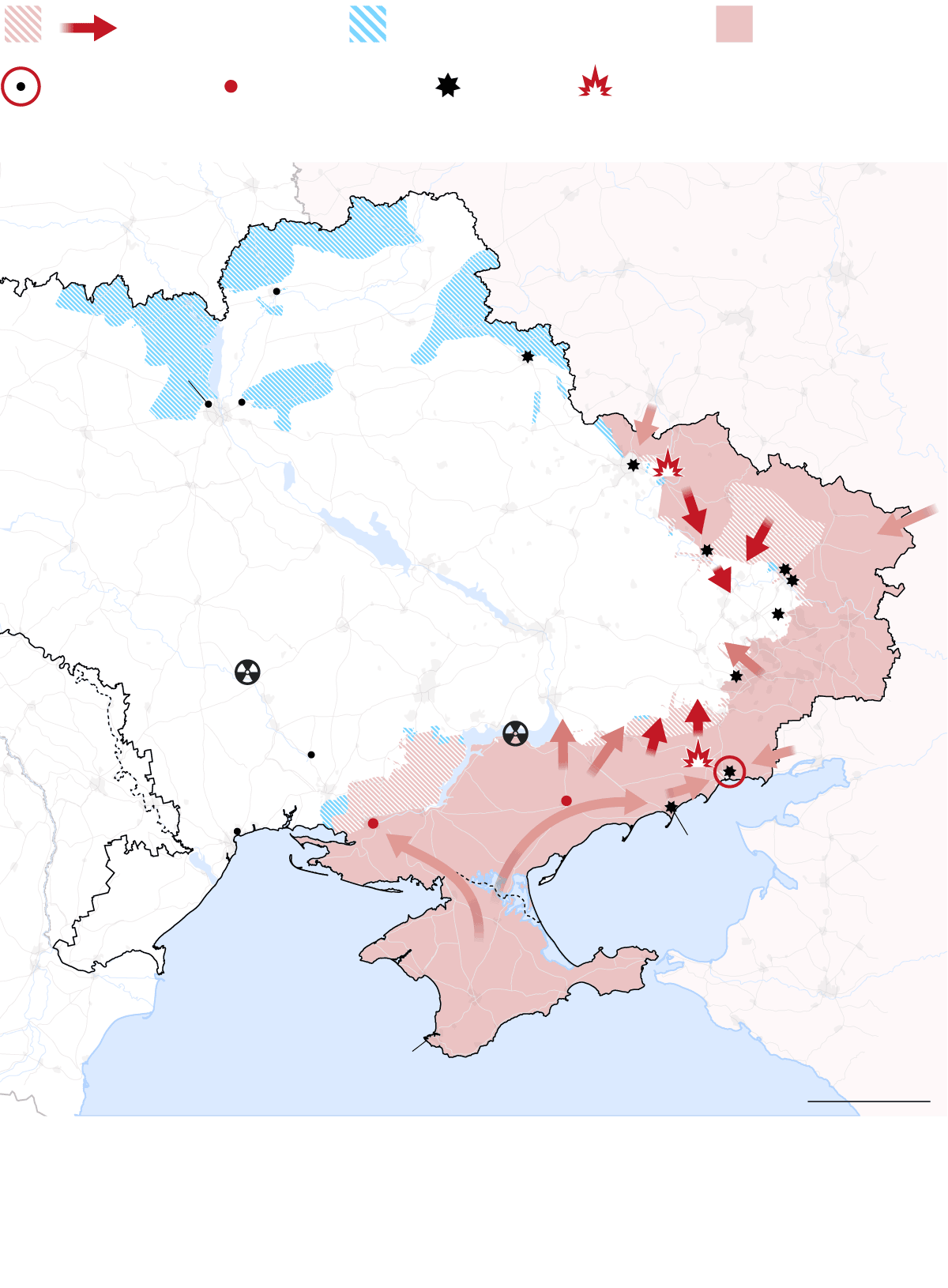
Area recovered by Ukraine
Russian movements
Russian control
Besieged city
City controlled
by the Russians
Recent
fighting
Recent
bombing
BELAURUS
Kursk
RUSSIA
Chernihiv
Sumy
Irpin
Brovary
Belgorod
Makariv
Yitomir
Kyiv
Kharkiv
Izyum
Rubizhne
UKRAINE
Severo-
donetsk
Sloviansk
Lugansk
Dnipro
Popasna
DONBAS
Krivoi Rog
Zaporizhzhia
Donetsk
Nuclear power plant
Mykolaiv
MOLD.
Melitopol
Kherson
Odessa
Mariupol
Berdiansk
Sea of Azov
CRIMEA
Annexed by Russia
in 2014
Black Sea
250 km
Note: What does “control” mean? It requires exerting a physical influence over an area to prevent its use by the enemy. It could be achieved by occupying the area or by holding power over it with weapons. It does not imply any form of governance or legitimacy. Sources: Institute for the Study of War and American Enterprise Institute’s Critical Threats Project (for advances and areas under control); UK intelligence (besieged cities); EL PAÍS and other sources (fighting and airstrikes).
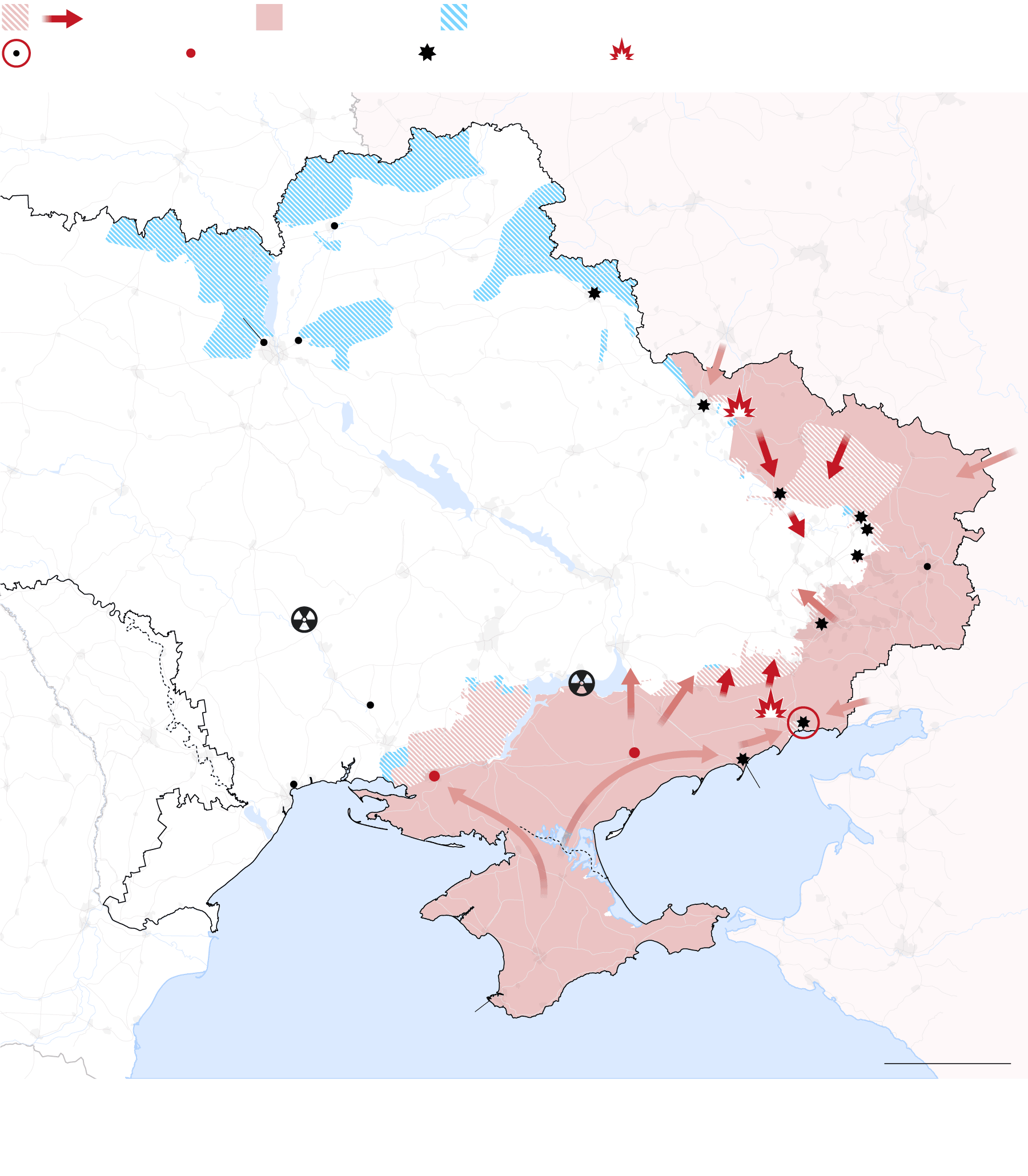
Russian movements
Area recovered by Ukraine
Russian control
Besieged city
City controlled
by the Russians
Recent
fighting
Recent
bombing
BELAURUS
Kursk
RUSSIA
Chernihiv
Sumy
Irpin
Brovary
Belgorod
Makariv
Kyiv
Yitomir
Kharkiv
Izyum
UKRAINE
Rubizhne
Severodonetsk
Sloviansk
Dnipro
Popasna
Lugansk
DONBAS
Krivoi Rog
Zaporizhzhia
Donetsk
Nuclear power plant
Mykolaiv
MOLD.
Melitopol
Odessa
Kherson
Mariupol
Berdiansk
Sea of Azov
CRIMEA
Annexed by Russia
in 2014
Black Sea
250 km
Note: What does “control” mean? It requires exerting a physical influence over an area to prevent its use by the enemy. It could be achieved by occupying the area or by holding power over it with weapons. It does not imply any form of governance or legitimacy. Sources: Institute for the Study of War and American Enterprise Institute’s Critical Threats Project (for advances and areas under control); UK intelligence (besieged cities); EL PAÍS and other sources (fighting and airstrikes).
In the Izyum and Severodonetsk axes, the Russian army has kept up small attacks in the last 48 hours. Troops did not wait for reinforcements, and according to the ISW this has contributed to their “limited” gains. The institute also said that the Russians are sustaining significant losses. The Ukrainian General Staff said that two Russian battalions unsuccessfully tried to take Dovhenke and Dmytrivka.
Russian forces are regrouping in Kharkiv to reinforce the Izyum axis. When new troops arrive, the ISW expects them to advance in a southeast direction, although they might first veer southwest in a bid to encircle Ukrainian defensive positions on the road between Izyum and Slovyansk.
In the east, in the Luhansk region, Russian forces kept up their attacks on Severodonetsk and Rubizhne, which have so far proven unsuccessful. The ISW reported artillery fire and urban combat in these cities.
Mariupol has not fallen yet, but it is surrounded and the Ukrainians are losing ground. Local authorities estimated that between 20,000 and 22,000 people have died in the city since the offensive began. In the south, Russia’s goal appears to be to defend Kherson from Ukrainian counterattacks. Russian forces did not make any significant territorial gains in that region, said the ISW.
On Tuesday, the United Kingdom Defense Department analyzed the appointment of Russian general Alexander Dvornikov as the new war commander in Ukraine, describing the move as “an attempt to centralize command and control.” According to British intelligence services, “an inability to cohere and coordinate military activity has hampered Russia’s invasion to date.”
April 11 | A country divided in two
Ukraine appears to have been split in two. In the west, there is no fighting, although the situation is far from normal. In the morning, air raid sirens were warning of possible strikes in cities such as Lviv and Kyiv. Meanwhile, in the east, where the Kremlin said it wants to focus its efforts, the war has continued to escalate.
The bulk of Russia’s forces are now focused on trying to advance in the Luhansk region. The troops may currently be trying to join the north-south axis from Donetsk to Kharkiv, by passing the cities of Slovyansk and Izyum, as can be seen in the map below. This would allow them to surround the Ukrainian fighters who remain in the area and take control of the entire region.
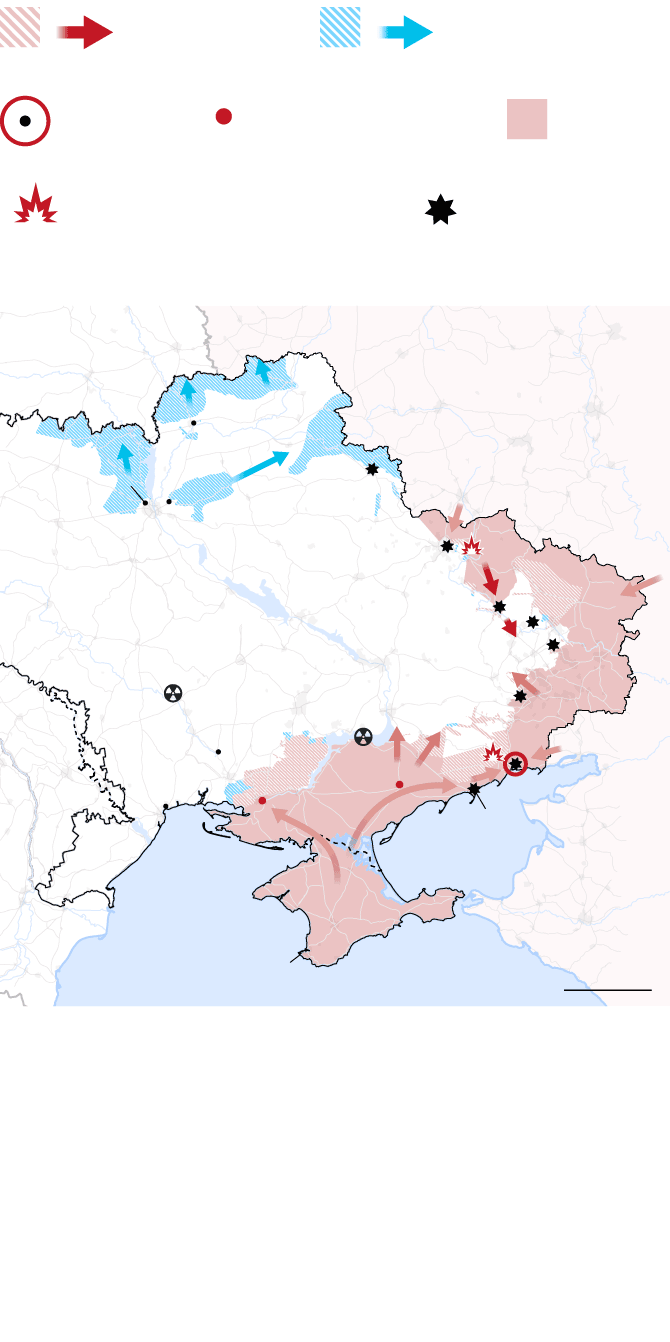
Russian
movements
Ukrainian
movements
City controlled
by the Russians
Russian
control
Besieged
city
Recent bombing
Recent
fighting
Kursk
BELARUS
RUSSIA
Chernihiv
Belgorod
Sumy
Irpin
Brovary
Makariv
Kyiv
Kharkiv
Rubizhne
Izyum
UKRAINE
Lugansk
Sloviansk
Dnipro
Popasna
Donbas
Zaporizhzhia
Donetsk
Mykolaiv
MOLD.
Melitopol
Odessa
Kherson
Mariupol
Berdiansk
Sea of Azov
CRIMEA
Annexed by Russia
in 2014
Black Sea
250 km
Note: What does “control” mean? It requires exerting a physical influence over an area to prevent its use by the enemy. It could be achieved by occupying the area or by holding power over it with weapons. It does not imply any form of governance or legitimacy. Sources: Institute for the Study of War and American Enterprise Institute’s Critical Threats Project (for advances and areas under control); UK intelligence (besieged cities); EL PAÍS and other sources (fighting and airstrikes).
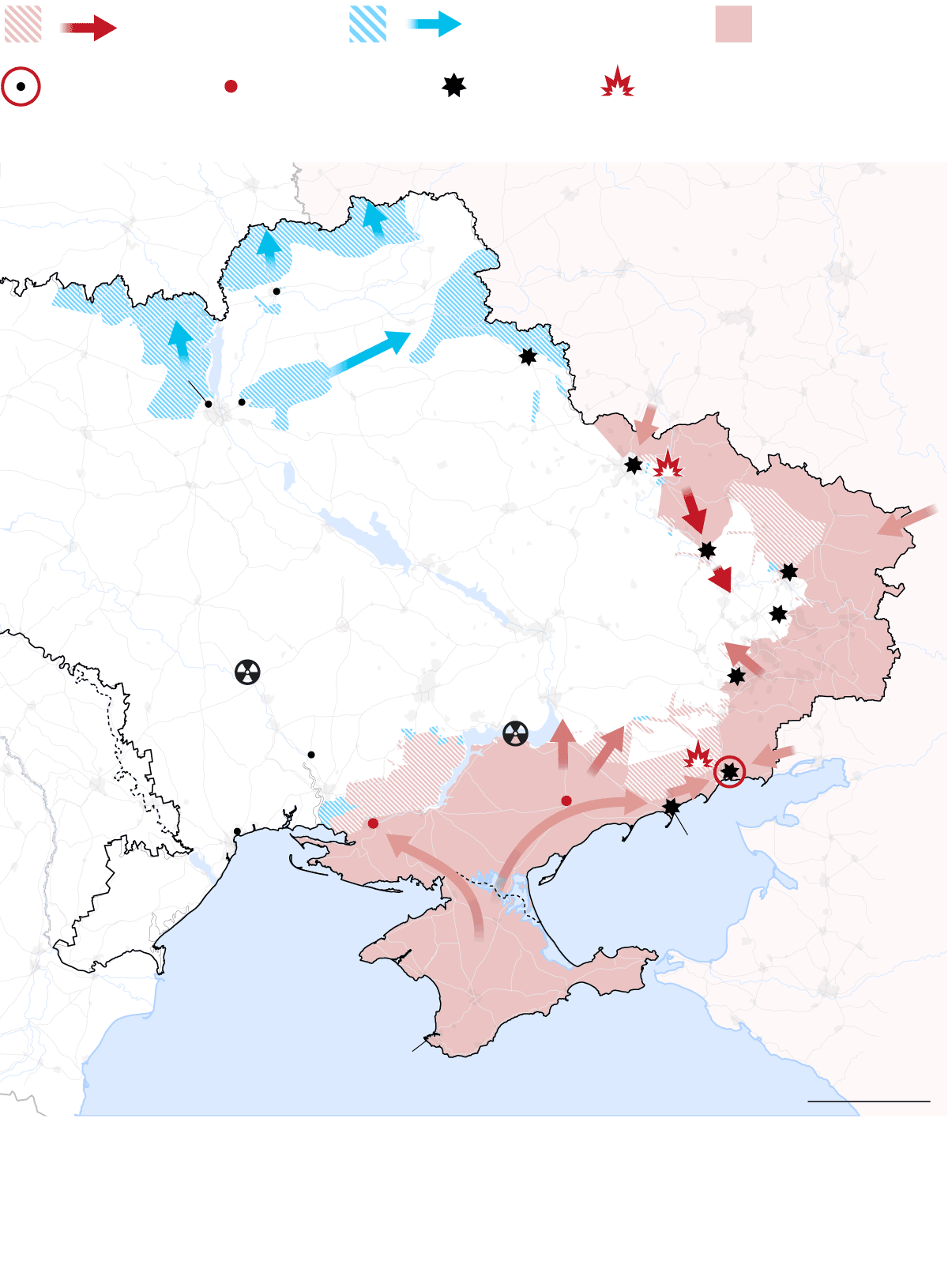
Ukrianian movements
Russian movements
Russian control
Besieged city
City controlled
by the Russians
Recent
fighting
Recent
bombing
Kursk
RUSSIA
Chernihiv
Sumy
Irpin
Brovary
Belgorod
Makariv
Yitomir
Kyiv
Kharkiv
Izyum
Rubizhne
Sloviansk
Lugansk
UKRAINE
Popasna
Dnipro
Krivoi Rog
Donbas
Donetsk
Nuclear power plant
Mykolaiv
MOLD.
Melitopol
Kherson
Mariupol
Odessa
Berdiansk
Sea of Azov
Black Sea
Annexed by Russia
in 2014
250 km
Note: What does “control” mean? It requires exerting a physical influence over an area to prevent its use by the enemy. It could be achieved by occupying the area or by holding power over it with weapons. It does not imply any form of governance or legitimacy. Sources: Institute for the Study of War and American Enterprise Institute’s Critical Threats Project (for advances and areas under control); UK intelligence (besieged cities); EL PAÍS and other sources (fighting and airstrikes).
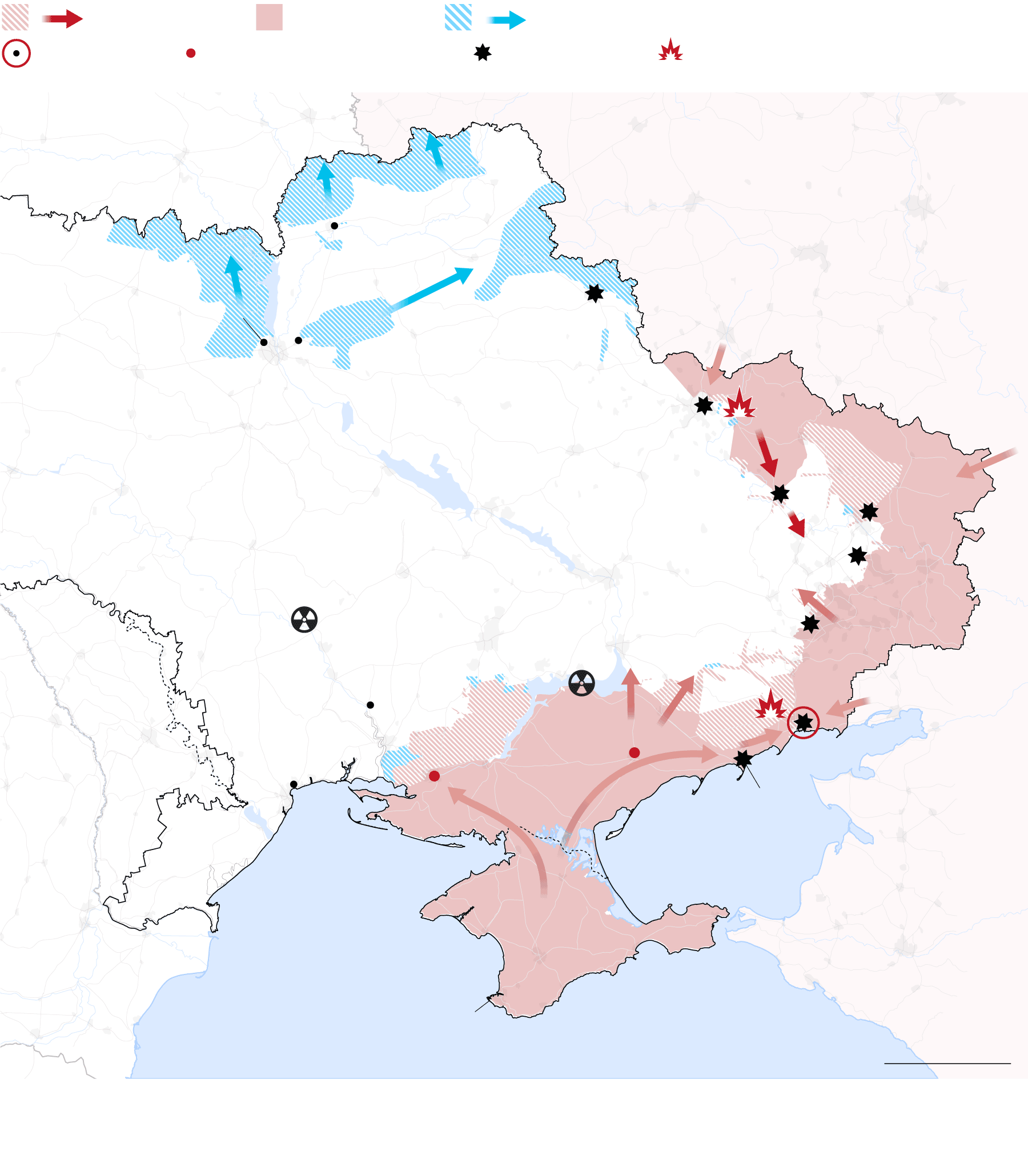
Russian movements
Ukrainian movements
Russian control
Besieged city
City controlled by the Russians
Recent fighting
Recent bombing
BELARUS
Kursk
RUSSIA
Chernihiv
Sumy
Irpin
Belgorod
Brovary
Makariv
Kyiv
Yitomir
Kharkiv
Rubizhne
Izyum
UKRAINE
Sloviansk
Lugansk
Dnipro
Popasna
Krivoi Rog
Donbas
Zaporizhzhia
Donetsk
Nuclear power plant
Mykolaiv
MOLD.
Melitopol
Mariupol
Odessa
Kherson
Berdiansk
Sea of Azov
CRIMEA
Annexed by Russia
in 2014
Black Sea
250 km
Note: What does “control” mean? It requires exerting a physical influence over an area to prevent its use by the enemy. It could be achieved by occupying the area or by holding power over it with weapons. It does not imply any form of governance or legitimacy. Sources: Institute for the Study of War and American Enterprise Institute’s Critical Threats Project (for advances and areas under control); UK intelligence (besieged cities); EL PAÍS and other sources (fighting and airstrikes).
This is the reason why there have been numerous bombings in this area, as well as fighting in the cities of Rubizhne, Popasna and Severodonetsk. According to the ISW, Russia has been unable to seize this territory thanks to the efforts of the Ukrainian resistance.
Russian troops who were in the Kharkiv area may try to move towards this area from Izyum in an effort to support the attacks in the region. Satellite images captured by Maxar Technologies support this hypothesis: they show a 100 kilometer-long (62 miles) convoy of vehicles north of Izyum.

Velykyi Burluk
Kharkiv
Kupiansk
50 km
A Russian convoy is heading towards the Donbas region, as can be seen in these satellite images taken between April 8 and 9. MAXAR TECHNOLOGIES, EFE and GOOGLE MAPS.
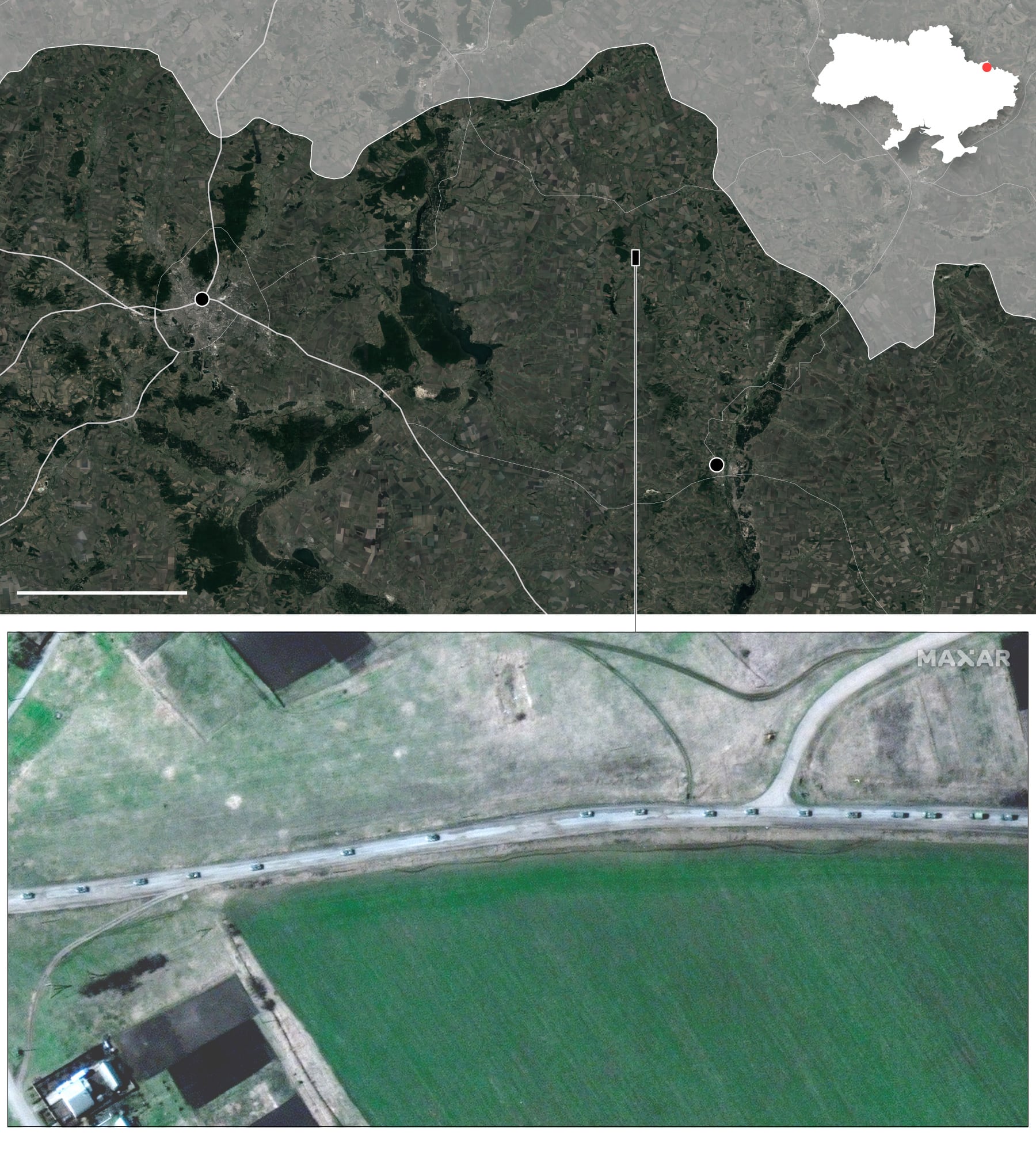
Velykyi
Burluk
Kharkiv
Kupiansk
50 km
A Russia convoy is heading towards the Donbas region, as can be seen in these satellite images taken between April 8 and 9.
MAXAR TECHNOLOGIES, EFE and GOOGLE MAPS.
Further to the south, the Russians are gaining more ground in Mariupol, which has been under siege for more than a month. The defenders may be cut off in the southeast of the city, close to the port. In this area, as well as the city center (where Russian troops have already set up checkpoints, a telling sign of their control of the area) there is still fighting between the forces of both countries.
A major unknown is what will happen with the Russian troops who were stationed near Kyiv up until 15 days ago. According to the US Defense Department, these battalions have been reduced to a fraction of what they were when they were deployed to surround the capital at the start of the war. This source, in line with what NATO spokespeople have said in the past few days, indicates that these Russian units suffered such great material and physical losses that it will be weeks before they can be sent to another front. This setback, in addition to the difficulty Russia is having in replenishing its forces with new men, may prove impossible to resolve in the context of a short-term war, states the ISW.
April 9 | The last defense of Mariupol
After being besieged for more than a month, Ukrainian troops in Mariupol remained in control of at least two key points in the southeast and the east of the city. According to the latest report from the ISW, these areas are the port and Azovstal, which is one of Europe’s biggest steel works. “The battle goes on and it is not clear how much longer the Ukrainian defenders will be able to hold out,” the ISW said.
The battle for the port of the city and its surroundings has been escalating since at least March 6. A satellite image taken by Earth imaging company Planet Labs on this date shows smoke rising up from a number of different points at the port. A day later, sensors from NASA’s Landsat 8 satellite also recorded heat spots – possibly due to the fighting – in the same area.
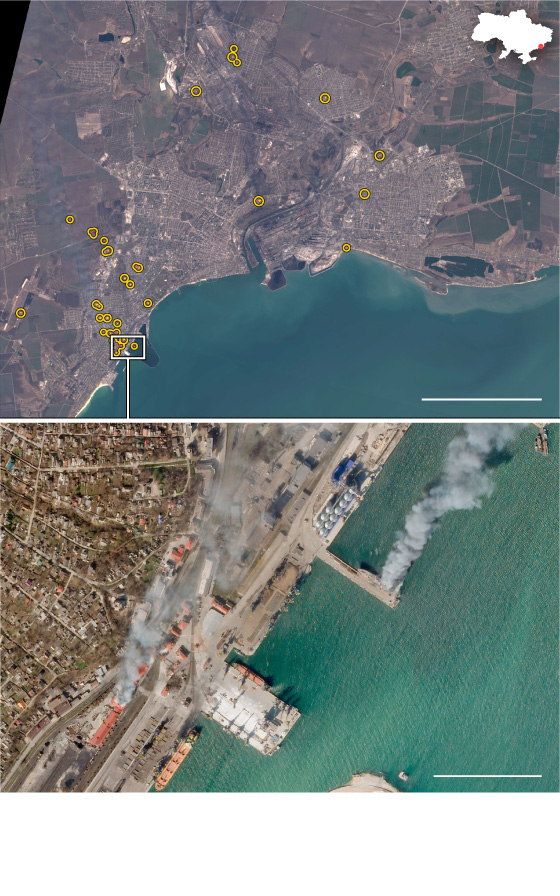
Hot spots detected by the sensors of the Landsat 8 satellite
mariupol
Tahanroz'ka Gulf
5 km
250 m
Analysis based on images from NASA’s Landsat 8 satellite taken on April 7 and from the Earth imaging company Planet Labs via AP.
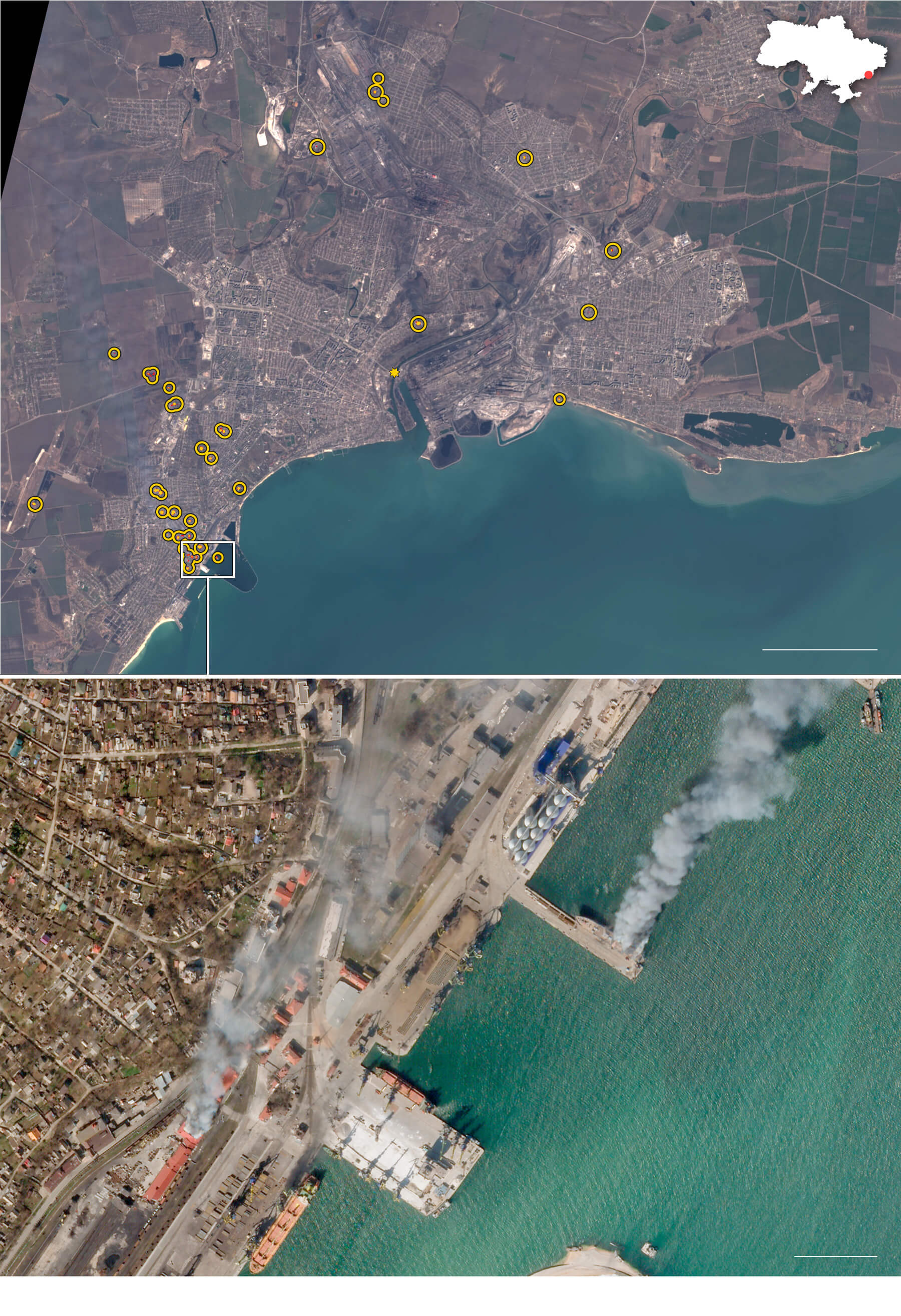
Hot spots detected by the sensors of the Landsat 8 satellite
mariupol
Russia captures an entrance to the steel factory Azovstal on April 7
Detail below
Tahanroz'ka Gulf
3 km
120 m
Analysis based on images from NASA’s Landsat 8 satellite taken on April 7 and from the Earth imaging company Planet Labs via AP.
The fighting in the southern port city was happening as the Kremlin renewed its offensive in the east. On Friday, Ukrainian soldiers managed to repel seven Russian attacks, and announced they had destroyed four tanks, two artillery systems and 11 vehicles. Putin’s troops, concentrated in the cities of Popasna and Rubizhne, had not made significant advances in the past 24 hours, but continued bombing the area. One strike, on a train station in Kramatorsk, killed at least 52 people and left more than 100 injured.
The most recent British intelligence report warned that an increase in aerial activity should be expected in Mariupol and Donbas, which has already been strengthened with the launch of cruise missiles from Russia’s naval forces. “However, the Russian goal to establish an overland corridor between the Crimea and Donbas continues to be frustrated,” the report added.
The Russian axis that is advancing from Izyum to Slovyansk has also not made progress. These troops are intended to strengthen Russia’s operations in Donetsk and Luhansk. Meanwhile, in Kharkiv, Russia continued to bomb civilian infrastructure. The ISW stated that Ukraine may be planning a counterattack in Kherson, in the southeast, and confirmed that Russian troops have completely withdrawn from the city of Sumi, in the northeast of Ukraine.
